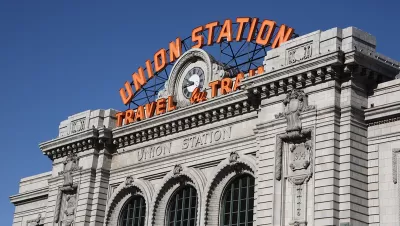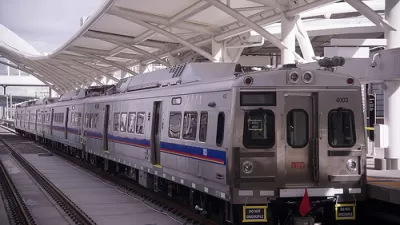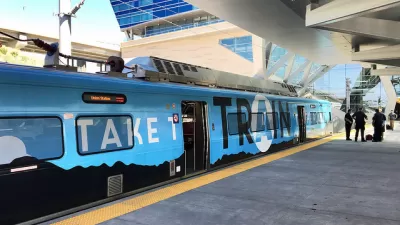You will be forgiven for thinking you are looking at an East Coast commuter rail line: It's electrified with level boarding, mostly 15-minute headways, with bike and luggage racks, operating 22 hours a day from Denver's Union Station to the airport.

Don't look for the "Train to the Plane" at Union Station. Instead, "it goes by name 'RTD University of Colorado A Line', which takes its name as a result of the first sponsorship through the Regional Transportation District's naming rights program," states Monte Whaley of The Denver Post (listen and watch here). During construction, it's referred to as the East Line.
Public-private partnership, cost, rail cars
The highly anticipated line is electric commuter rail, which is part of the Eagle P3 project, the nation's first full public-private partnership for transit.
As a June 2010 Planetizen post on the project indicates, "RTD board voted 13-0 to select a team called Denver Transit Partners, composed of "Fluor Enterprises Inc., Australia's Macquarie Capital Group and transit contractor Balfour Beatty Rail Inc. to build and operate a $2.1 billion portion of FasTracks". They will operate the line for 40 years."
"Local RTD taxes combined with a $1.03 billion federal grant and $450 million from Denver Transit Partners — the 34-year concessionaire that will build, operate and maintain the trains," writes Whaley.
According to an RTD FasTracks fact sheet (pdf) on the electric commuter rail vehicles and service that includes a comparison to light rail, the vehicles will be manufactured by Hyundai Rotem USA which calls them electric multiple units, or EMUs (not to be confused with the Australian ostrich-like bird).
[Note East and West Coast issues that have arisen with Hyundai Rotem commuter rail cars].
Days, hours and frequency of operation; stops and fares
Whaley writes that the fare for the 23-mile, 37-minute trip to the airport from Union Station is $9. RTD's A Line webpage indicates that the seven-day, 22-hour service and frequencies are truly oriented for airport travel:
-
3 - 6 a.m., every dayService every 30 minutes
-
6 a.m. - 8 p.m., every dayService every 15 minutes
-
8 p.m. - 1 a.m., every dayService every 30 minutes
Commuter rail will operate on a zone-based fare. There are seven stations in three zones, plus the airport (DIA) in its own zone, according to the fares page:
RTD indicates that the A Line will bring "train service into new neighborhoods and employment areas along Interstate 70."
With the inception of the new rail service to DIA in April, expect the airport's low accessibility rating to improve.
In addition to the A Line, look for two new electrified commuter rail lines to be opening next year: Gold Line and the first segment of the Northwest Rail. A fourth line will open in 2018.
Hat tip: Annie Dawid.
FULL STORY: RTD announces Union Station-to-DIA rail line will open April 22, 2016

Alabama: Trump Terminates Settlements for Black Communities Harmed By Raw Sewage
Trump deemed the landmark civil rights agreement “illegal DEI and environmental justice policy.”

Study: Maui’s Plan to Convert Vacation Rentals to Long-Term Housing Could Cause Nearly $1 Billion Economic Loss
The plan would reduce visitor accommodation by 25% resulting in 1,900 jobs lost.

Planetizen Federal Action Tracker
A weekly monitor of how Trump’s orders and actions are impacting planners and planning in America.

Waymo Gets Permission to Map SF’s Market Street
If allowed to operate on the traffic-restricted street, Waymo’s autonomous taxis would have a leg up over ride-hailing competitors — and counter the city’s efforts to grow bike and pedestrian on the thoroughfare.

Parklet Symposium Highlights the Success of Shared Spaces
Parklets got a boost during the Covid-19 pandemic, when the concept was translated to outdoor dining programs that offered restaurants a lifeline during the shutdown.

Federal Homelessness Agency Places Entire Staff on Leave
The U.S. Interagency Council on Homelessness is the only federal agency dedicated to preventing and ending homelessness.
Urban Design for Planners 1: Software Tools
This six-course series explores essential urban design concepts using open source software and equips planners with the tools they need to participate fully in the urban design process.
Planning for Universal Design
Learn the tools for implementing Universal Design in planning regulations.
Caltrans
Smith Gee Studio
Institute for Housing and Urban Development Studies (IHS)
City of Grandview
Harvard GSD Executive Education
Toledo-Lucas County Plan Commissions
Salt Lake City
NYU Wagner Graduate School of Public Service






























